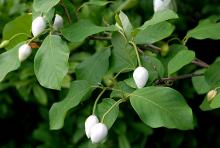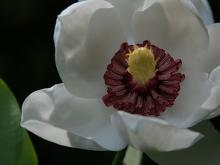Magnolia sieboldii
Common name:
Siebold Magnolia
Oyama Magnolia
Pronunciation:
mag-NO-li-a see-BOL-dee-i
Family:
Magnoliaceae
Genus:
Type:
Broadleaf
Native to (or naturalized in) Oregon:
No
- Broadleaf deciduous multistemmed shrub or small tree, 10-20 ft [3-6 m] high, young shoots thin, pubescent. Leaves alternate, simple, 10-15 cm long, broadly elliptic to obovate, tip abruptly acuminate, base rounded, dark green above, glabrous, blue-green below, at first pubescent, later only on midrib, 6-10 vein pairs. Flowers white, egg-shaped in bud, then cup-like, 7-10 cm wide, appearing after the leaves, fragrant, on a long stalk (3-6 cm) and nodding, usually 9-12 tepals (petals and sepals), filaments an attractive carmine-red. Fruit ovoid, 3-4 cm long, carmine, scarlet seeds.
- Part shade to full sun, best in moist, fertile, well-drained soil.
- Hardy to USDA Zone (5) 6 Native to southern China, Manchuria, Japan and Korea. With such a wide geographical distribution, winter hardiness likely varies with the selection grown. Magnolia sieboldii is growing at the Minnesota Landscape Arboretum, near Minneapolis. Ernest Wilson found it growing in the Diamond Mountains in northeastern Korea, "where winter temperature is more severe than in Massachusetts" (Gardiner, 2000).
- A single pure white flower of Magnolia sieboldii with foliage is associated with the Japanese tea ceremony.
- sieboldii: after Philipp Franz von Siebold (1796-1866), a German doctor who introduced many plants from Japan.
- Oregon State Univ. campus: at several entrances to Strand Ag. Hall (north, east, and south)










